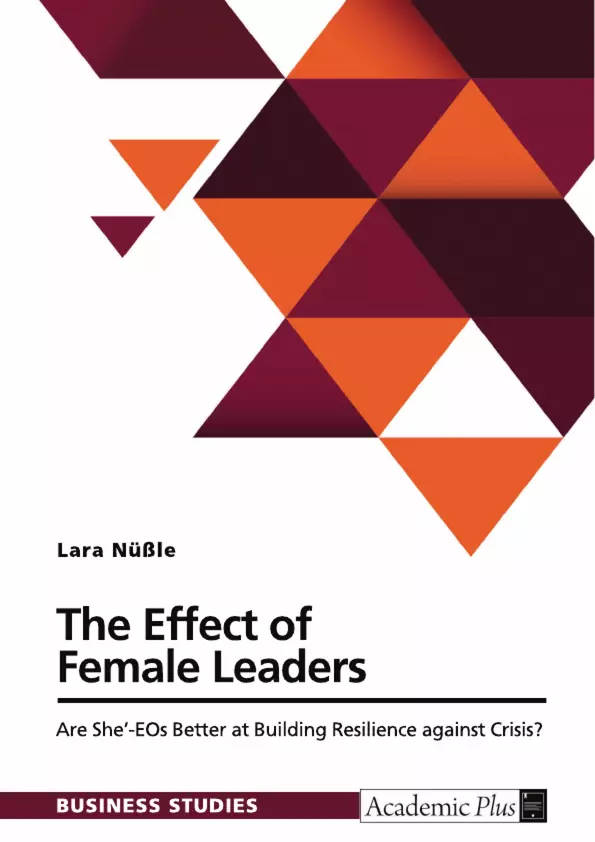This thesis explores whether female CEOs are better in crisis-related resilience measures in comparison to male CEOs. The research question is twofold: One part focuses on stability which is measuring the ability to absorb adverse events, the other part considers flexibility which captures the ability to bounce back from such events. Both hypotheses are developed via Social Role Theory and the communal behavior which females are considered to show more in comparison to males, given this theory. Empirically, the hypotheses are evaluated with a sample of S&P 1500 US companies within the first three years after the financial crisis in 2008. For stability, 1,152 companies were used, and an OLS regression suggests that female CEOs have a negative effect on stability. For flexibility, female CEOs show no significant difference within all the 952 firms of the considered subsample when applying a logit regression.
Overall, existing research provides incomplete and inconclusive results on the roles of She’-EOs (female CEOs) vs. male CEOs in creating resilience after crises. Thus, in this Master Thesis, I address the following two research questions: Do firms managed by She’-EOs (vs. male CEOs) have more stability for resilience against crises (i.e. operationalized as a lower drop in ROA after crisis) Do firms managed by She’-EOs (vs. male CEOs) have more flexibility for resilience against crises (i.e., operationalized as an earlier recovery of ROA after crisis)?
Inhaltsverzeichnis (Table of Contents)
- Abstract
- Table of Contents
- 1 Introduction
- 2 Theoretical and Conceptual Foundation of CEOs, Gender, Crisis and Resilience
- 2.1 The Role of CEOs through Upper Echelons Theory
- 2.2 Gender and Social Role Theory
- 2.3 Crisis, Crisis Management and Resilience
- 2.3.1 Crisis and Crisis Management
- 2.3.2 Resilience
- 2.3.2.1 Predictors of Resilience via Stability
- 2.3.2.2 Predictors of Resilience via Flexibility
- 2.3.3 Female Leaders in Crisis and Resilience
- 3 The Effects of She'-EOs on Resilience against a Crisis
- 3.1 Hypothesis 1: The Effect of She'-EOs on Stability
- 3.2 Hypothesis 2: The Effect of She'-EOs on Flexibility
- 4 Context, Sample and Methodology
- 4.1 Context The Financial Crisis 2008
- 4.2 Data and Sample
- 4.3 Measures
- 4.3.1 Main Variables
- 4.3.2 Control Variables
- 4.4 Empirical Strategy
- 5 Results
- 5.1 Data Preparation
- 5.2 Hypothesis 1: The Effect of She'-EOs on Stability
- 5.3 Hypothesis 2: The Effect of She’-EOs on Flexibility
- 6 Discussion
- 6.1 Summary of Main Findings
- 6.2 Theoretical Implications
- 6.3 Managerial Implications
- 6.4 Limitations and Directions for Future Research
Zielsetzung und Themenschwerpunkte (Objectives and Key Themes)
This thesis investigates the relationship between female leadership and organizational resilience during crises, specifically focusing on the financial crisis of 2008. The research aims to determine whether female CEOs are more effective than their male counterparts in navigating and recovering from such crises.
- The impact of female leadership on organizational resilience during crises
- The role of Social Role Theory in explaining gender differences in crisis management
- The effectiveness of female CEOs in promoting organizational stability and flexibility during crisis
- Empirical analysis of S&P 1500 US companies following the financial crisis of 2008
- Theoretical and managerial implications for CEO selection, board composition, and crisis preparedness.
Zusammenfassung der Kapitel (Chapter Summaries)
The thesis begins by providing a theoretical foundation for the study, exploring the roles of CEOs, gender dynamics within leadership, and the concept of crisis and resilience. This chapter delves into Social Role Theory and its implications for understanding gender differences in organizational behavior. The second chapter focuses on the research hypotheses. It posits that female CEOs may be better at promoting stability and flexibility in times of crisis. The methodology of the study is detailed in Chapter 4, outlining the context of the financial crisis, the sample of S&P 1500 US companies, the key variables used, and the analytical approach employed.
Chapter 5 presents the results of the empirical analysis, focusing on the impact of female CEOs on both stability and flexibility. This chapter also discusses the findings in relation to the hypotheses presented earlier. The discussion chapter (Chapter 6) summarizes the key findings, outlining the theoretical and managerial implications of the study. The chapter also acknowledges the limitations of the research and proposes directions for future inquiry.
Schlüsselwörter (Keywords)
The key terms and concepts explored in this thesis encompass organizational resilience, stability, flexibility, female leadership, crisis management, Social Role Theory, and the financial crisis of 2008. The study uses a diverse range of methodologies and data sources, drawing on the S&P 1500 US companies data to analyze the relationship between female leadership and organizational resilience.
- Quote paper
- Lara Nüßle (Author), 2022, The Effect of Female Leaders. Are She’-EOs Better at Building Resilience against Crisis?, Munich, GRIN Verlag, https://www.grin.com/document/1485112



